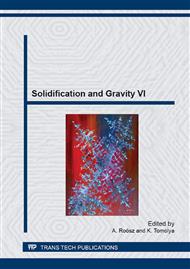p.279
p.285
p.291
p.296
p.302
p.311
p.317
p.323
p.329
On the Relationship between Inclusions and Pores, Part II: Dendritic Structure, Pressure Drop in the Liquid and Pore Precipitation
Abstract:
There is a relationship between pores and inclusions. As hypothesis goes, inclusions have an affinity to gather inside the pores and form clusters. Focus of this paper is how solidified dendritic structure affects the pressure field in the liquid and pore precipitation in austenitic stainless steel. Steel sample is a continuously cast bloom. Temperature profile and width of the mushy zone of the strand is modeled according to a constant temperature at the strands surface. Thermal analysis has been performed with differential thermal analysis (DTA) and differential scanning calorimeter (DSC). Dendrite arm spacing (DAS) is measured with light optical microscopy (LOM) and scanning electron microscopy (SEM). DAS is represented as the weight average of the distance between parallel sets of primary dendrite stems. Pressure field is calculated based on Darcys law. Pore formation is described through segregation of the gas components and pressure field in the liquid.
Info:
Periodical:
Pages:
302-307
Citation:
Online since:
May 2014
Authors:
Keywords:
Price:
Сopyright:
© 2014 Trans Tech Publications Ltd. All Rights Reserved
Share:
Citation:


